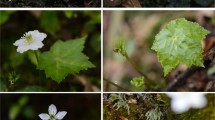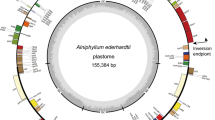Abstract
Detailed chloroplast DNA restriction site maps for two species in the genusAdonis (Ranunculaceae),A. annua andA. vernalis, were constructed using single and double digests and the sizes of these genomes are 151.3 and 156.5 kilobases, respectively. Three inversions were found inAdonis, relative to the gene order in the majority of land plants. These rearrangements represent two different gene orders and mark an ancient split in the evolutionary history of this genus. Gene probes were used in order to map the endpoints of the inversions and the inverted repeat regions. The inverted repeat is approximately 400 base pairs shorter inA. annua than inA. vernalis. Two inversions, 39 kilobases and 24 kilobases in size, occur inA. annua and one inversion, 42 kilobases in size, is present in the remaining investigated species ofAdonis. The generps16 is absent from the chloroplast genome inAdonis annua. Restriction sites for eleven restriction endonucleases were mapped forA. annua, A. vernalis and four additional species ofAdonis and two species ofTrollius. Eighty-six phylogenetically informative sites were analysed cladistically in order to evaluate the main clades withinAdonis.
Similar content being viewed by others
References
Bremer K. (1988) The limits of amino acid sequence data in angiosperm phylogenetic reconstruction. Evolution 42: 795–803.
Castroviejo S., Laínz M., López González G., Montserrat P., Muñoz Garmendia F., Paiva J., Villar L. (eds.) (1986) Flora Iberica. Plantas vasculares de la Península Ibérica e Islas Baleares. Lycopodiaceae-Papaveraceae. Real Jardín Botánico, C.S.I.C., Madrid.
Chrtek J., Slavíková Z. (1978) Gliederung der Gattung Adonis in drei Gattungen. Preslia 50: 22–25.
Clarke A.K., Gustafsson P., Lidholm J. Å. (1994) Identification and expression of the chloroplastclpP gene in the coniferPinus contorta. Pl. Molec. Biol. 26: 851–862.
Cosner M. E., Jansen R. K., Palmer J. D., Downie S. R., (1997) The highly rearranged chloroplast genome ofTrachelium caeruleum (Campanulaceae): multiple inversions, inverted repeat expansion and contraction, transposition, insertions/deletions, and several repeat families. Curr. Genet. 31: 419–429.
Downie S. R., Palmer J. D. (1992) Use of chloroplast DNA rearrangements in reconstructing plant phylogeny. In: Soltis P. S., Soltis D. E., Doyle J. J. (eds.) Molecular systematics of plants. Chapman and Hall, New York, pp. 14–35.
Downie S. R., Palmer J. D. (1994) A chloroplast DNA phylogeny of the Caryophyllales based on structural and inverted repeat restriction site variation. Syst. Bot. 19: 236–252.
Downie S. R., Olmstead R. G., Zurawski G., Soltis D. E., Soltis P. S., Watson J. C., Palmer J. D. (1991) Six independent losses of the chloroplast DNArpl2 intron in dicotyledons: molecular and phylogenetic implications. Evolution 45: 1245–1259.
Downie S. R., Katz-Downie D. S., Wolfe K. H., Calie P. J., Palmer J. D (1994) Structure and evolution of the largest chloroplast gene (ORF2280): internal plasticity and multiple gene loss during angiosperm evolution. Curr. Genet. 25: 367–378.
Downie S. R., Llanas E., Kats-Downie D. S. (1996) Multiple independent losses of therpoC1 intron in angiosperm chloroplast DNA 's. Syst. Bot. 221: 135–151.
Doyle J. J., Doyle J. L. (1987) A rapid DNA isolation procedure for small quantities of fresh leaf tissue. Phytochem. Bull. 19: 11–15.
Doyle J. J., Davis J. I., Soreng R. J., Garvin D., Anderson M. J. (1992) Chloroplast DNA inversions and the origin of the grass family (Poaceae). Proc. Natl. Acad. Sci. USA 89: 7722–7726.
Doyle J. J., Doyle J. L., Palmer J. D. (1995) Multiple independent losses of two genes and one intron from legume chloroplast genomes. Syst. Bot. 20: 272–294.
Doyle J. J., Doyle J. L., Ballenger J. A., Palmer J. D. (1996) The distribution and phylogenetic significance of a 50-kb chloroplast DNA inversion in the flowering plant familyLeguminosae. Molec. Phylogenet. Evol. 5: 429–438.
Felsenstein J. (1985) Confidence limits on phylogenies: an approach using the bootstrap. Evolution 39: 783–791.
Hachtel W., Neuss A., Stein J. vom (1991) A chloroplast DNA inversion marks an evolutionary split in the genusOenothera. Evolution 45: 1050–1052.
Heyn C. C., Pazy B. (1989) The annual species ofAdonis (Ranunculaceae) — a polyploid complex. Plant Syst. Evol. 168: 181–193.
Hiratsuka J., Shimada H., Whittier R., Ishibashi T., Sakamoto M., Mori M., Kondo C., Honji Y., Sun C.-R., Meng B-Y., Li Y.-Q., Kanno A., Nishizawa Y., Hirai A., Shinozaki K., Sugiura M. (1989) The complete sequence of the rice (Oryza sativa) chloroplast genome: intermolecular recombination between distinct tRNA genes accounts for a major plastid DNA inversion during the evolution of the cereals. Molec. Gen. Genet. 217: 185–194.
Hoot S. B. (1995) Phylogeny of theRanunculaceae based on preliminaryatpB,rbcL and 18S nuclear ribosomal DNA sequence data. Plant Syst. Evol., Suppl. 9: 241–251.
Hoot S. B., Palmer J. D. (1994) Structural rearrangements, including parallel inversion, within the chloroplast genome ofAnemone and related genera. J. Molec. Evol. 38: 274–281.
Howe C. J. (1985) The endpoints of an inversion in wheat chloroplast DNA are associated with short repeated sequences containing homology toatt-lambda. Curr. Genet. 10: 139–145.
Howe C. J., Barker R. F., Bowman C. M., Dyer T. A. (1988) Common features of three inversions in wheat chloroplast DNA. Curr. Genet. 13: 343–349.
Johansson J. T. (1995) A revised chloroplast DNA phylogeny of theRanunculaceae. Plant Syst. Evol., Suppl. 9: 253–261.
Johansson J. T., Jansen R. K. (1991) Chloroplast DNA variation among five species ofRanunculaceae: structure, sequence divergence, and phylogenetic relationships. Plant Syst. Evol. 178: 9–25.
Johansson J. T., Jansen R. K. (1993) Chloroplast DNA variation and phylogeny of theRanunculaceae. Plant Syst. Evol. 187: 29–49.
Kanno A., Hirai A. (1993) A transcription map of the chloroplast genome from rice (Oryza sativa). Curr. Genet. 23: 166–174.
Knox E. B., Downie S. R., Palmer J. D. (1993) Chloroplast genome rearrangements and the evolution of giant lobelias from herbaceous ancestors. Molec. Biol Evol. 10: 414–430.
Kohchi T., Ogura Y., Umesono K., Yamada Y., Komano T., Ohyama K. (1988) Ordered processing and splicing in a polycistronic stranscript in liverwort chloroplasts. Curr. Genet. 14: 147–154.
Komarov V. L. (ed.) (1970) Flora of the U.S.S.R. (Flora SSSR). 7.Ranales andRhoeadales. Translated from Russian. Moskow, Leningrad: Botanical Institute of the Academy of Sciences of the U.S.S.R.
Milligan B. G., Hampton J. N., Palmer J. D. (1989) Dispersed repeats and structural re-organization in sub-clover chloroplast DNA. Molec. Biol. Evol. 6: 355–368.
Ogihara Y., Terachi T., Sasakuma T. (1988) Intramolecular recombination of chloroplast genome mediated by short direct-repeat sequences in wheat species. Proc. Natl. Acad. Sci. USA 85: 8573–8577.
Palmer J. D. (1986) Isolation and structural analysis of chloroplast DNA. Meth. Enzymol. 118: 167–186.
Palmer J. D. (1991) Plastid chromosomes: structure and evolution. In: Bogorad L., Vasil I. K. (eds.) Cell culture and somatic cell genetics in plants, 7. The molecular biology of plastids. Academic Press, New York, pp. 5–53.
Palmer J. D., Osorio B., Thompson W. F. (1988) Evolutionary significance of inversions in legume chloroplast DNAs. Curr. Genet. 14: 65–74.
Ro K.-E., Keener C. S., McPheron B. A. (1997) Molecular phylogenetic study of theRanunculaceae: utility of the nuclear 26S ribosomal DNA in inferring intrafamilial relationships. Molec. Phylogenet. Evol. 8: 117–127.
Santisuk T. (1979) A palynological study of the tribeRanunculeae (Ranunculaceae). Opera Bot. 48: 1–74.
Shinozaki K., Ohme M., Tanaka M., Wakasugi T., Hayashida N., Matsubayashi T., Zaita N., Chunwongse J., Obokata J., Yamaguchi-Shinozaki K., Ohto C., Torazawa K., Meng B. Y., Sugita M., Deno H., Kamogashira T., Yamada K., Kusuda J., Takaiwa F., Kato A., Tohdoh N., Shimada H., Sugiura M. (1986) The complete nucleotide sequence of the tobacco chloroplast genome: its gene organization and expression. EMBO J. 5: 2043–2049.
Strid A. (1986)Adonis. In: Strid A. (ed.) Mountain flora of Greece, 1. Cambridge, Cambridge University Press, pp. 209–210.
Sugiura M., Zaita N., Kusuda M., Kumano M. (1986) Clone bank of the tobacco (Nicotiana tabacum) chloroplast genome as a set of overlapping restriction endonuclease fragments: mapping of eleven ribosomal protein genes. Pl. Sci. 44: 211–216.
Swofford D. L. (1993) PAUP. Phylogenetic analysis using parsimony, version 3.1.1 for Macintosh Computer package. Illinois Natural History Survey, Champaign, Illinois.
Swofford D. L. Olsen G. J., Waddell P. J., Hillis, D. M., (1996) Phylogenetic inference. In: Hillis D. M., Mortiz C., Mable B. K. (eds.) Molecular systematics, 2nd edn. Sinauer, Sunderland, MA, pp. 407–514.
Tamura M. (1993)Ranunculaceae. In: Kubitzki K., Rohwer, J. G., Bittrich, V. (eds.) The families and genera of vascular plants. 2. Flowering plants. Dicotyledons. Magnoliid, hamamelid and caryophyllid families. Springer, Berlin Heidelberg New York, pp. 563–583.
Tsal C.-H., Strauss S. H. (1989) Dispersed repetitive sequences in the chloroplast genome of Douglas-fir. Curr. Genet. 16: 211–218.
Tutin T. G. Akeroyd J. R. (1993)Adonis L. In: Tutin T. G., Burges N. A., Chater A. O., Edmondson J. R., Heywood V. H., Moore D. M., Valentine D. H., Walters S. M., Webb D. A. (eds.) Flora Euopeaea, 2nd edn., 1, Cambridge University Press, Cambridge, pp. 267–269.
Watrous L. E., Wheeler Q. D. (1981) The out-group comparison method of character analysis. Syst. Zool. 30: 1–11.
Weglöhner W., Subramanian A. R., (1992) Nucleotide sequence of a region of maize chloroplast DNA containing the 3′ end ofclpP, exon 1 ofrps12 andrpl20 and their cotranscription. Pl. Molec. Biol. 18: 415–418.
Author information
Authors and Affiliations
Rights and permissions
About this article
Cite this article
Johansson, J.T. There large inversions in the chloroplast genomes and one loss of the chloroplast generps16 suggest an early evolutionary split in the genusAdonis (Ranunculaceae) . Pl Syst Evol 218, 133–143 (1999). https://doi.org/10.1007/BF01087041
Received:
Accepted:
Issue Date:
DOI: https://doi.org/10.1007/BF01087041




